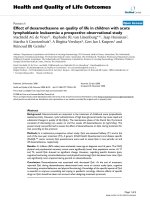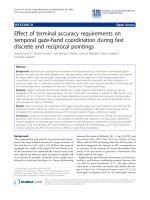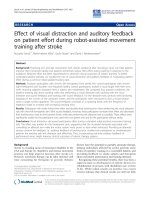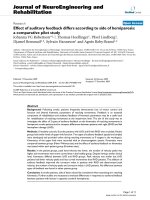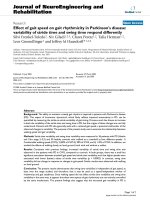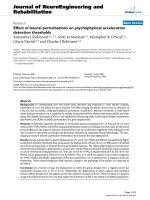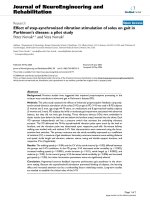Báo cáo hóa học: " Effect of Temperature Gradient Direction in the Catalyst Nanoparticle on CNTs Growth Mode" docx
Bạn đang xem bản rút gọn của tài liệu. Xem và tải ngay bản đầy đủ của tài liệu tại đây (977.53 KB, 10 trang )
NANO EXPRESS
Effect of Temperature Gradient Direction in the Catalyst
Nanoparticle on CNTs Growth Mode
An-Ya Lo
•
Shang-Bin Liu
•
Cheng-Tzu Kuo
Received: 1 October 2009 / Accepted: 17 May 2010 / Published online: 26 June 2010
Ó The Author(s) 2010. This article is published with open access at Springerlink.com
Abstract To improve the understanding on CNT growth
modes, the various processes, including thermal CVD,
MP-CVD and ECR-CVD, have been used to deposit CNTs
on nanoporous SBA-15 and Si wafer substrates with C
2
H
2
and H
2
as reaction gases. The experiments to vary process
parameter of DT, defined as the vector quantities of tem-
perature at catalyst top minus it at catalyst bottom, were
carried out to demonstrate its effect on the CNT growth
mode. The TEM and TGA analyses were used to charac-
terize their growth modes and carbon yields of the pro-
cesses. The results show that DT can be used to monitor the
temperature gradient direction across the catalyst nano-
particle during the growth stage of CNTs. The results also
indicate that the tip-growth CNTs, base-growth CNTs and
onion-like carbon are generally fabricated under conditions
of DT [ 0,\0 and *0, respectively. Our proposed growth
mechanisms can be successfully adopted to explain why
the base- and tip-growth CNTs are common in thermal
CVD and plasma-enhanced CVD processes, respectively.
Furthermore, our experiments have also successfully
demonstrated the possibility to vary DT to obtain the
desired growth mode of CNTs by thermal or plasma-
enhanced CVD systems for different applications.
Keywords CNTs Á Growth mechanism Á Base-growth Á
Tip-growth Á CVD
Introduction
Starting with Ijima’s [1] discovery of carbon nanotubes
(CNTs), there has been continual discovery and investiga-
tion into a series of CNTs using various CVD systems
[1–31]. There are different ways to classify CNTs, such as
by number of walls (Single-/double-/Multi-) [2–5], chirality
(zigzag/chiral/armchair) [5–7], tube morphology (bamboo-
like/hollow, or helix/straight) [8, 9], cap morphology (close/
open) [10] or growth mode (tip-/base-growth) [11–34].
Various applications require different properties in CNTs
[35–44]. Therefore, controlling the structures and properties
of CNTs has been one of the important issues in CNTs
syntheses. Scientists have proposed many CNT growth
mechanisms and corresponding fabrication methods to
better control performance [23, 31–34, 45–55]. However,
studies have overlooked some important factors regarding
CNT growth modes and mechanisms.
About CNT growth modes, the adhesion force at catalyst/
substrate interface was first proposed by Bower’s group as
one of the most important factors [11]. Although tip-growth
CNTs are the most common CNTs grown through plasma-
enhanced chemical vapor deposition (CVD) [12–21], many
investigators are searching for ways to grow base-growth
CNTs by increasing adhesion force between the catalyst and
substrate. Some proposed methods include using a metal
catalyst to form metal-silicide with Si substrate, implanting
catalyst ions into the substrate and increasing the decom-
position temperature of the catalyst precursor [11, 51–54]. In
addition to adhesion force, researchers have also proposed
catalyst particle size [34, 55] and substrate porosity [23]as
A Y. Lo
Department of Materials Science and Engineering,
National Chiao Tung University, Hsinchu 300, Taiwan
S B. Liu
Institute of Atomic and Molecular Sciences, Academia Sinica,
Taipei 106, Taiwan
C T. Kuo (&)
Department of Materials Science and Engineering,
Ming Dao University, Changhua 52345, Taiwan
e-mail:
123
Nanoscale Res Lett (2010) 5:1393–1402
DOI 10.1007/s11671-010-9648-4
key factors affecting the growth modes. However, different
studies have yielded contradictory results [16, 21, 56].
Researchers have been slow to explain why tip-growth
[12–21] and base-growth [22–29] CNTs are always grown
by plasma-enhanced CVD and thermal CVD, respectively.
In other words, one may ignore some of the important
parameters in these cases, which should always be different
in plasma-enhanced CVD and thermal CVD.
The present research includes specially designed
experiments, testing different processes (thermal CVD,
MP-CVD and ECR-CVD) and substrates and varying the
possible process parameters to examine their effects on
CNT growth modes. This paper also proposes possible
growth mechanisms.
Experimental Details
Catalysts Deposition and Substrates Materials
The substrates in this work include mesoporous SiO
2
SBA-
15 powders and (100) silicon wafer, where SBA-15 prep-
aration was reported earlier by Zhao et al. [57]. To coat Co
catalysts on the SBA-15 substrate, the substrate was first
added into 0.1 M (Co(NO
3
)
3(aq)
solution. The filtered SBA-
15 substrates with precipitates from solution were then
dried, and its precipitates were decomposed into cobalt
oxide (CoO
x
) in an air furnace under 125°C. The Co oxides
were subsequently reduced to Co in a hydrogen furnace at
800°C. The Co coatings of 10 nm thick on Si wafer were
deposited by sputtering method.
The CNTs Deposition by Thermal CVD
The CNTs were deposited on Co-coated substrates (i.e.,
mesoporous SBA-15 powders and Si wafer) by thermal
CVD method with C
2
H
2
and H
2
as reaction gases. A
schematic diagram of thermal CVD is shown in Fig. 1.In
order to vary the temperature difference between gas and
substrate temperatures, the system consists of a gas pre-
heating zone and a substrate heating zone. The specimen
holder is made of the porous quartz fiber nets for better gas
penetration. In other words, the main feature of this system
is that the direction of temperature gradient on each cata-
lyst can be manipulated. Specimen designations and their
deposition conditions are shown in Table 1.
The CNTs Deposition by Plasma-Enhanced CVDs
The plasma-enhanced CVDs for CNTs deposition include
MP-CVD and ECR-CVD with 2.45 GHz microwave and
tunable DC bias. As described in thermal CVD, the Co
catalyst for CNTs growth is first deposited on Si wafer by
PVD process. The Co-coated substrates are then pre-treated
in H-plasma atmosphere to dissociate Co film to become
catalyst nanoparticles. The pre-treated substrates are fol-
lowed by CNTs deposition with C
2
H
2
and H
2
as reaction
gases (C
2
H
2
/H
2
= 10/50 (sccm/sccm)). Specimen desig-
nations and their deposition conditions are listed in
Table 2.
Characterization Methods
The CNTs on specimens were ultrasonically agitated in
acetone to delaminate CNTs from the substrate, disperse
and then dry on a copper grid prior to the TEM examina-
tion (JEOL JEM-2100F) operated at 200 keV. The TGA
(Thermogravimetric Analysis) is used to determine carbon
yield as a function of the reaction time under various
deposition conditions, where carbon yield is defined by (wt.
of carbon, W
c
)/(wt. of carbon ? catalyst ? SBA-15)) for
CNTs deposited on SBA-15 substrate by thermal CVD
process.
Results and Discussion
Inherent Condition Differences of Thermal
and Plasma-Enhanced CVD
The experiment results revealed that most of the CNTs
deposited by plasma-enhanced CVD and by thermal CVD
generally grow in the tip-growth [12–21] and base-growth
[22–29] modes, respectively. The results indicated the
adhesion force between catalyst and substrate to be the main
factor in CNT growth modes [11, 30]. However, the adhe-
sion force mechanism does not fully explain the differences
in CNT growth modes in different growth systems. One
possible factor that researchers sometimes overlook is the
direction of the temperature gradient across the catalyst. In
the thermal CVD process, substrate temperatures (T
S
) are
Fig. 1 Schematic diagram of a thermal CVD system with a pre-
heating zone
1394 Nanoscale Res Lett (2010) 5:1393–1402
123
often maintained at a certain level, and reaction gases are
generally delivered into the reaction chamber without pre-
heating. As a result, the temperature on the top of the cat-
alyst (T
Ct
), which is in contact with the flowing gases, is
generally lower than the temperature at the bottom side of
the catalyst (T
Cb
), which is in contact with the substrate
(Fig. 2.) In contrast, with plasma-enhanced CVD, micro-
waves generally ionize the reaction gases to attain the
plasma state, which often reaches higher temperatures than
the substrate temperature. In other words, the temperature at
Table 1 Specimen designations and their deposition conditions by thermal CVD
Spec. desig.
a
t
b
(min) Catalyst/substrate Sub. surface
condition
c
Temp.
d
T
G
/T
S
(°C/°C) DT
e
CNTs growth
mode
A1–5 5 Co/SBA-15 R 25/800 – Base-growth
A1–10 10
A1–15 15
A1–20 20
A1–30 30
A1–40 40
A1–65 65
A1–90 90
A2–20 20 Co/Si (001) S 25/800 – Base-growth
A3–20 20 Co/SBA-15 R 800/600 ? Tip-growth
A4–20 20 Co/Si (001) S 800/600 ? Tip-growth
A5–20 20 Co/SBA-15 R 650/650 *0 No CNTs
A6–5 5 Co/SBA-15 R 800/800 *0 No CNTs
A6–10 10
A6–15 15
A7–5 5 No cata./SBA-15 R 25/800 – No CNTs
A7–10 10
A7–15 15
A8–5 5 No cata./SBA-15 R 800/800 *0 No CNTs
A8–15 15
A8–25 25
a
Other deposition conditions: H
2
/C
2
H
2
= 50/50 (sccm/sccm); 3 kPa pressure
b
t: CNTs deposition time
c
Conditions of the substrate surface, R Rough (porous) and S Smooth surface
d
T
G
: the pre-heated temperature of the reaction gas; T
S
: the substrate temperature at heating zone
e
DT = temperature of catalyst at the top minus at the bottom. Its sign represents the temperature gradient direction
Table 2 Specimen designations and their deposition conditions by plasma-enhanced CVD
Spec. desig. Method
a
W
pre
/W
gro
b
(W/W) Bias
b
V
pre
/V
gro
(V/V) T
S
b
T
Si
/T
Sf
(°C/°C) Dep. Time
c
(min) DT
d
Growth Mode
B1 MP 800/800 100/120 467/500 5 ? Tip-growth
B2 1,000/600 100/60 520/507 2 - Base-growth
C1 ECR 250/270 100/120 500/530 5 ? Tip-growth
C2 300/240 120/100 750/631 4 - Base-growth
a
MP Microwave plasma CVD, ECR Electron cyclotron resonance CVD, The working pressures in MP and ECR are 1.3 kPa and 0.9 Pa,
respectively
b
W
pre
, and V
pre
= microwave power, and bias voltage during the H-plasma pre-treatment step (H
2
= 50 sccm), respectively
W
dep
,V
dep
, T
Si
, and T
Sf
= microwave power, bias voltage, initial and final substrate temperature of the deposition step (H
2
/C
2
H
2
flow ratio =
50/10 (sccm/sccm); pressure = 10 Torr), respectively
c
CNTs deposition time in minute
d
DT = temperature of catalyst at the top minus at the bottom. Its sign represents the temperature gradient direction
Nanoscale Res Lett (2010) 5:1393–1402 1395
123
the top of catalyst particles that are in contact with or are
close to the plasma zone is higher than the temperature at
the bottom that is in contact with the substrate. Therefore,
the direction of the temperature gradient across the catalyst
particles is essentially downward and upward in thermal
and plasma-enhanced CVD, respectively. These tempera-
ture differences are the main reason for differences in CNT
growth modes.
By defining DT as the vector quantities of catalyst
temperature at the top minus the catalyst temperature at the
bottom side [Fig. 2 and Eq. (1)] DT is generally\0 and[0
for CNTs that come from thermal and plasma-enhanced
CVD, respectively. DT is an index for determining the
direction of the temperature gradient across the catalyst
particles. To examine the effect of DT on CNT growth
modes, this study performs experiments designed to vary
the DT values from negative to positive.
DT ¼ T
Ct=V
À T
Cb=S
ð1Þ
CNT Growth Under Different Surface Morphologies
of Substrate by Thermal CVD
Figure 3a, b shows that the typical TEM bright field
and corresponding dark field images, respectively, of
as-deposited CNTs on nanoporous SBA-15 substrate by
thermal CVD without pre-heating reaction gases (Speci-
men A1-20). Figures 3 and 4 show the corresponding TEM
images of CNTs on smooth Si wafers (Specimen A2-20).
These images suggest that CNTs deposited on either
nanoporous or smooth substrate surfaces undergo base-
growth modes, as the literature reports for CNTs grown by
thermal CVD [22–29]. One of the reported factors deter-
mining CNT growth modes is the adhesion force between
catalyst and substrate [11]. However, it is unlikely to apply
in these cases. Since the SBA-15 substrates have a much
rougher surface than Si wafer substrates, the adhesion
between the catalyst and Si wafer substrates is generally
greater than between the catalyst and SBA-15 substrates,
due to the decrease in real area in contact [58]. Clearly, the
difference in adhesion force between catalysts and sub-
strates does not change the CNT growth mode in these
cases. In other words, DT \0 may be the main factor in
these cases and is also the typical condition in thermal
CVD processes.
Fig. 2 Schematic diagrams to show the temperature distribution
across a catalyst particle for different deposition systems: a thermal
CVD and b plasma-enhanced CVD systems
Fig. 3 TEM images of the as-deposited CNTs on SBA-15 substrate
by thermal CVD without gas pre-heating: a bright field and
b corresponding dark field images (Specimen A1–20)
1396 Nanoscale Res Lett (2010) 5:1393–1402
123
Effect of DT on CNT Growth
To further confirm the effect of DT on CNT growth, this
study performed two experiments (Specimens A3-20 and
A4-20 in Table 1) with the same growth condition of
DT [ 0, designed to deposit CNTs by thermal CVD on the
mesoporous SBA-15 and Si wafer substrates, respectively.
In these two cases, the reaction gases were pre-heated to
higher temperatures than the substrate before entering the
reaction chamber to raise DT over zero. Figures 5a, b and
6a, b show the corresponding TEM images of the tip-
growth CNTs deposited on the mesoporous SBA-15 and Si
wafer substrates, respectively, under conditions of DT [ 0
(Fig. 6b is at higher magnification). Except for the catalyst
being located at the tip of the CNTs (as the arrows point),
the blurred microstructure frequently found in these cases
(Figs. 5b, 6a) is the most obvious difference compared to
CNTs grown under conditions of DT \0. One can observe
the microstructure of graphite walls and bamboo-like tube
structure using a high-resolution TEM (Fig. 6b). Figures 3,
45and 6 suggest that the sign of DT is the predominant
parameter apart from substrate morphology. The effect of
adhesion force between the catalyst and substrate does not
explain the growth mode of CNTs in these cases.
This study also conducted three experiments (Specimens
A6–5, A6–10 and A6–15 in Table 1) to deposit CNTs by
thermal CVD with the condition of DT * 0. Figure 7a, b
shows the typical TEM images of deposits on SBA-15
substrate for Specimen A6–5 (Fig. 7b is at higher magni-
fication). The SBA-15 images are clear, and the catalysts
particles can become poisoned after less than 5 min of
deposition time by acquiring graphite-like layers to form an
Fig. 4 TEM image of the as-deposited CNTs on Si wafer substrate
by thermal CVD without gas pre-heating a low magnification and
b higher magnification images (Specimen A2–20)
Fig. 5 TEM images of the as-deposited CNTs on SBA-15 substrate
by thermal CVD with gas pre-heating (gas temperature [substrate
temperature): a well-structured CNTs and b CNTs with blurred
microstructure (Specimen A3–20)
Nanoscale Res Lett (2010) 5:1393–1402 1397
123
onion-like structure, signifying no obvious growth rate or
growth mode.
TGA Curves of CNTs Under Various DT
TGA analyses of CNTs deposited on SBA-15 substrates by
thermal CVD were conducted to determine the wt% of the
constituents in the specimen, using a heating rate of 5°C/
minute and air flow rate of 15 sccm. The typical TGA
curve from room temperature to 800°C for CNTs deposited
by thermal CVD without gas pre-heating is shown in Fig. 8
(Specimen A1–20). From the TGA curves, carbon yield, as
defined in Eq. 2, can be derived, which represents an index
of the total carbon content produced after process in the
specimen, including CNTs,.
yieldðwt%Þ¼
W
c
100 ÀW
w
 100 ð2Þ
where W
w
is the first stage weight loss around 100°C,
owing to H
2
O absorbed in the hydrophilic SBA-15 sub-
strate. W
c
is the second stage weight loss, attributable to the
oxidation reaction of carbon with oxygen, and the residue
weight is mainly attributable to Co/SBA-15 or SBA-15 for
specimens without a catalyst.
Figure 9 shows the curves of carbon yield as a function
of deposition time for four different thermal CVD pro-
cesses. For conditions of DT \ 0, Fig. 9a, c shows the
TGA curves for carbons deposited on SBA-15 substrates
under the same substrate and gas temperatures
(T
S
= 800°C; T
G
= 25°C) with and without Co catalyst,
respectively (Specimens A1- and A7-series). The slope of
Fig. 6 TEM images of the as-deposited CNTs on Si wafer substrate
by thermal CVD with gas pre-heating (gas temperature [substrate
temperature): a low magnification and b higher magnification images
(Specimen A4–20)
Fig. 7 TEM images of the as-deposited carbon structure on SBA-15
substrate by thermal CVD with gas pre-heating (gas tempera-
ture = substrate temperature): a low magnification and b higher
magnification images (Specimen A6–5)
1398 Nanoscale Res Lett (2010) 5:1393–1402
123
the curves is basically the growth rates of various carbon
species. In Fig. 9a, the curve is roughly dividable into two
straight lines, representing the growth of two different
species. It is interesting to note that the first and the second
straight lines in Fig. 9a represent the growth of CNT and
non-CNT carbon species, respectively. The following evi-
dences confirm this. First, the growth of CNTs can take up
to 20 min, as observable in Fig. 3, showing the TEM image
of CNTs at the intersection of the first and the second lines
in Fig. 9a. Second, the slope of the second line (0.33 wt%/
min) is almost parallel to that in Fig. 9c, which represents
the growth of non-CNTs species without catalyst applica-
tion. In other words, the catalyst that assists the growth of
CNTs becomes poisoned after a certain deposition time (20
min in this case) [21, 59–65].
For the condition of DT * 0, Fig. 9b, d show two
curves of carbon yield as a function of deposition time for
growth of CNTs by thermal CVD on SBA-15 substrates
with and without Co as catalyst, respectively. Notably, the
two curves have almost the same slope. Figure 9b and the
TEM onion-like image in Fig. 7 suggest that there is no
CNTs growth, but rather onion-like carbon growth up to
5 min before Co-catalyst becomes poisoned.
The earlier analyses successfully demonstrate the DT
across the catalyst nanoparticle to be one of the major
factors in thermal CVD determining the growth mode of
CNTs. The DT is essentially an index of temperature gra-
dient direction across a catalyst nanoparticle. The results
indicate that the base-growth and tip-growth modes of
CNTs by thermal CVD are preferred under DT \0 and [0,
respectively.
Growth Mode of CNTs by Plasma-Enhanced CVD
To test the effect of DT on the growth mode of CNTs
deposited by plasma-enhanced CVD, the MP-CVD and
ECR-CVD were used to grow CNTs under DT [ 0 and
DT \ 0. In the case of plasma-enhanced CVD, the
manipulation of DT is obtainable by using the scheme in
Fig. 10, which shows the temperature variation during the
process. During the pre-treatment stage, the temperature is
rapidly increased from room temperature to the initial
substrate temperature, T
si
, which is defined as the begin-
ning temperature of the substrate during the growth stage
of CNTs. Immediately after the substrate’s pre-treatment
stage comes a heating or cooling growth stage, which is
manipulated by adjusting the microwave power and the
substrate bias. The continuous increase or decrease in the
substrate temperature signifies heating or cooling from
the plasma to the substrate through catalyst nanoparticles,
i.e., DT [ 0or\0 across the nanoparticle, respectively.
The substrate temperatures during the growth stage were
0 200 400 600 800
60
65
70
75
80
85
90
95
100
W
C
W
W
weight loss (wt%)
Temperature (
°
C)
Fig. 8 TGA curve of the as-deposited CNTs on SBA-15 substrate by
thermal CVD without gas pre-heating (Specimen A1–20)
Fig. 9 Carbon yield (wt%) versus deposition time curves of the as-
deposited CNTs deposited by thermal CVD for specimens with
different deposition conditions: a A1, b A6, c A7 and d A8-series,
respectively
Fig. 10 Schematic drawn to show substrate temperature variations of
two different process sequences in growth stage, a temperature-rising
and b temperature-declining
Nanoscale Res Lett (2010) 5:1393–1402 1399
123
monitored to insure the heating or cooling effects, and its
final temperature, T
sf
, appears in Table 2.
Figure 11a, b shows TEM images of CNTs deposited by
MP-CVD under conditions of DT [ 0 and\0, respectively.
This indicates that a difference in DT does make a differ-
ence in the growth mode of CNTs, as the tip-growth and
base-growth modes are quite obvious in Fig. 11a, b,
respectively. Moreover, same conclusions apply for CNTs
deposited by ECR-CVD, as Fig. 12a, b show in TEM
images of CNTs grown under conditions of DT [ 0 and
\0, respectively.
Similar investigation indicates that plasma treatment
may also affect the growth mode by decreasing the bond
between catalyst and substrate [33]. However, this does
little to control or define the bond strength between cata-
lysts and substrates, due to the fact that catalyst
nanoparticles are in a liquid state during the high temper-
ature CNT growth process [5, 66]. In other words, our
experimental results suggest an alternative synthesis route
to achieve CNTs with a customized growth mode, which
can probably overcome the uncertainty of adhesion force.
Controlling the temperature gradient direction can achieve
both modes of CNTs by thermal CVD, MP-CVD and ECR-
CVD.
Proposed DT Model for CNT Growth Modes
Figure 13a, b illustrates the conditions of DT \ 0 and [0,
respectively, elucidating the effect of DT on CNT growth
modes. The process during growth stage is roughly divid-
able into two steps. Figure 13a illustrates the concept of the
Fig. 11 TEM images of the as-deposited CNTs on Si wafer substrate
by MP-CVD with schemes of a temperature-rising and b temperature-
declining sequences in Fig. 10, respectively (Specimens B1 and B2)
Fig. 12 TEM images of the as-deposited CNTs on Si wafer substrate
by ECR-CVD with schemes of a temperature-rising and b temper-
ature-declining sequences in Fig. 10, respectively (Specimens C1 and
C2)
1400 Nanoscale Res Lett (2010) 5:1393–1402
123
base-growth mode (DT \ 0), which is the mode of tradi-
tional thermal CVD systems and specially designed
plasma-enhanced CVD systems. In Step 1, the precursors
are decomposed and/or reacted with the substrate to pro-
duce carbon species; they are then dissolved by catalyst
nanoparticles. The solution of carbon species in the catalyst
nanoparticle can proceed until reaching the solubility limit
at the substrate temperature. In Step 2, the cooling effect of
precursor flow causes the temperature at the top surface of
the catalyst particle to be lower than the temperature at the
bottom surface. Therefore, carbon supersaturation in the
catalyst is higher close to its top surface than to its bottom
surface. Carbon precipitation is thus more likely to occur
on the top surface of the catalyst to form base-growth
CNTs. Furthermore, due to its endothermic nature, the
precipitation of carbon on the top surface of catalysts can
result in a local cooling effect and can further enhance the
DT effect [62, 67]. In contrast, Fig. 13b illustrates the
condition of DT [ 0, where the gas or plasma is at a higher
temperature than the substrate. In this case, carbon in the
catalyst is likely to precipitate on the cooler bottom side,
pushing the catalyst upward to form tip-growth CNTs.
Conclusions
This study’s experiments successfully demonstrate the
effect of DT on CNT catalyst nanoparticles deposited on
SBA-15 and Si wafer substrates by thermal and plasma-
enhanced CVD. This study defines DT as the temperature at
the top surface side minus the temperature at the bottom
side of a catalyst particle during a CNT’s growth stage. It is
essentially an index of the temperature gradient direction
across a catalyst particle. This study’s results demonstrate
that tip-growth and base-growth CNTs have a greater
tendency to form under the conditions of DT [ 0 and \0,
respectively. When DT = 0, the non-CNTs or onion-like
carbon may be more likely to form. This study proposes
mechanisms to explain effect of DT on CNT growth modes.
Acknowledgments The authors would like to acknowledge the
support of the National Science Council of Taiwan, under Contract
No. NSC 98-2221-E-451-001.
Open Access This article is distributed under the terms of the
Creative Commons Attribution Noncommercial License which per-
mits any noncommercial use, distribution, and reproduction in any
medium, provided the original author(s) and source are credited.
References
1. S. Iijima, Nature 354, 56 (1991)
2. J. Wei, B. Jiang, X. Zhang, H. Zhu, D. Wu, Chem. Phys. Lett.
376, 753 (2003)
3. S. Iijima, T. Ichihashi, Nature 363, 603 (1993)
4. D.S. Bethune, C.H. Klang, M.S. de Vries, G. Gorman, R. Savoy,
J. Vazquez, R. Beyers, Nature 363, 605 (1993)
5. R. Saito, M. Fujita, G. Dresselhaus, M.S. Dresselhaus, Appl.
Phys. Lett. 60, 2204 (1992)
6. H. Zhu, K. Suenaga, A. Hashimoto, K. Urita, S. Iijima, Small 1,
1180 (2005)
7. M. Ge, K. Sattler, Appl. Phys. Lett. 65, 18–2284 (1994)
8. S. Amelinckx, X.B. Zhang, D. Bernaerts, X.F. Zhang, V. Ivanov,
J.B. Nagy, Science 265, 635 (1994)
9. D. Bernaerts, X.B. Zhang, X.F. Zhang, S. Amelinckx, G. Van
Tendeloo, J. Van Landuyt, V. Ivanov, J.B. Nagy, Philos. Mag. A
71, 605 (1995)
10. Z.W. Pan, S.S. Xie, B.H. Chang, L.F. Sun, W.Y. Zhou, G. Wang,
Chem. Phys. Lett. 299, 97 (1999)
11. C. Bower, O. Zhou, W. Zhu, D.J. Werder, S. Jin, Appl. Phys.
Lett. 77, 2767 (2000)
12. A.J. Hart, B.O. Boskovic, A.T.H. Chuang, V.B. Golovko, J.
Robertson, B.F.G. Johnson, A.H. Slocum, Nanotechnology 17,
1397 (2006)
13. C.T. Kuo, C.H. Lin, A.Y. Lo, Diam. Relat. Mater. 12, 799 (2003)
14. C.H. Lin, H.L. Chang, C.M. Hsu, A.Y. Lo, C.T. Kuo, Diam.
Relat. Mater. 12, 1851 (2003)
15. Y. Abdi, J. Koohsorkhi, J. Derakhshandeh, S. Mohajerzadeh,
H. Hoseinzadegan, M.D. Robertson, J.C. Bennet, X. Wu,
H. Radamson, Mater. Sci. Eng. C 26, 1219 (2006)
16. H.Y. Yap, B. Ramaker, A.V. Sumant, R.W. Carpick, Diam. Relat.
Mater. 15, 1622 (2006)
17. Z.F. Ren, Z.P. Huang, J.W. Xu, J.H. Wang, P. Bush, M.P. Siegal,
P.N. Provencio, Science 282, 1105 (1998)
Fig. 13 Our proposed CNTs growth mechanisms: a base-growth
model and b tip-growth model
Nanoscale Res Lett (2010) 5:1393–1402 1401
123
18. C.M. Hsu, C.H. Lin, H.L. Chang, C.T. Kuo, Thin Solid Films
420, 225 (2002)
19. H. Murakami, M. Hirakawa, C. Tanaka, H. Yamakawa, Appl.
Phys. Lett. 76, 1776 (2000)
20. Y. Chen, D.T. Shaw, L. Guo, Appl. Phys. Lett. 76, 2469
(2000)
21. P.L. Chen, J.K. Chang, C.K. Kuo, F.M. Pan, Diam. Relat. Mater.
13, 1949 (2004)
22. C.J. Lee, J. Park, Appl. Phys. Lett. 77, 3397 (2000)
23. S. Fan, M.G. Chapline, N.R. Franklin, T.W. Tombler, A.M.
Cassell, H. Dai, Science 283, 512 (1999)
24. G.S. Choi, Y.S. Cho, S.Y. Hong, J.B. Park, K.H. Son, D.J. Kim, J.
Appl. Phys. 91, 3847 (2002)
25. G. Gulino, R. Vieira, J. Amadou, P. Nguyen, M.J. Ledoux, S.
Galvagno, G. Centi, C. Pham-Huu, Appl Catal A Gen 279,89
(2005)
26. N. Zhao, C. He, Z. Jiang, J. Li, Y. Li, Mater. Lett. 60, 159 (2006)
27. C.J. Lee, S.C. Lyu, Y.R. Cho, J.H. Lee, K.I. Cho, Chem. Phys.
Lett. 341, 245 (2001)
28. K.S. Choi, Y.S. Cho, S.Y. Hong, J.B. Park, D.J. Kim, J. Eur.
Ceram. Soc. 21, 2095 (2001)
29. C.J. Lee, D.W. Kim, T.J. Lee, Y.C. Choi, Y.S. Park, Y.H. Lee,
W.B. Choi, N.S. Lee, G.S. Park, J.M. Kim, Chem. Phys. Lett.
312, 461 (1999)
30. A.C. Dupuis, Prog. Mater. Sci. 50, 929 (2005)
31. A.V. Melechko, V.I. Merkulov, D.H. Lowndes, M.A. Guillorn,
M.L. Simpson, Chem. Phys. Lett. 356, 527 (2002)
32. W.Y. Lee, T.X. Liao, Z.Y. Juang, C.H. Tsai, Diam. Relat. Mater.
13, 1232 (2004)
33. A. Malesevic, H. Chen, T. Hauffman, A. Vanhulsel, H. Terryn,
C.V. Haesendonck, Nanotechnology 18, 455602 (2007)
34. C. Li, H. Zhu, K. Suenaga, J. Wei, K. Wang, D. Wu, Mater. Lett.
63, 1366 (2009)
35. K. Hernadi, L. Thin-Nga, L. Forr, J. Phys. Chem. B 105(50),
12464 (2001)
36. K. Akagi, R. Tamura, M. Tsukasa, Phys. Rev. Lett. 74, 2307
(1995)
37. X. Chen, S. Motojima, H. Iwanaga, Carbon 37, 1825 (1999)
38. J. Cheng, X. Zhang, J. Tu, X. Tao, Y. Ye, F. Liu, Mater. Chem.
Phys. 95, 12 (2006)
39. W.H. Wang, K.M. Chao, C.T. Kuo, Diam. Relat. Mater. 14, 753
(2005)
40. R. Moradian, A. Fathalian, Nanotechnology 17, 1835 (2006)
41. G. Wu, B.Q. Xu, J. Power Sources 174, 148 (2007)
42. H.L. Chang, C.H. Lin, C.T. Kuo, Thin Solid Films 420–421, 219
(2002)
43. S.S. Wong, J.D. Harper, P.T. Lansbury Jr., C.M. Lieber, J. Am.
Chem. Soc. 120, 603 (1998)
44. C.V. Nguyen, K.J. Chao, R.M. Stevens, L. Delzeit, A. Cassell,
J. Han, M. Meyyappan, Nanotechnology 12, 363 (2001)
45. F. Ding, A.R. Harutyunyan, B.I. Yakobson, PNAS 106
, 2506
(2009)
46. S. Reich, L. Li, J. Robertson, Chem. Phys. Lett. 421, 469 (2006)
47. R. Gao, Z.L. Wang, S. Fan, J. Phys. Chem. B 104(6), 1227 (2000)
48. F. Ding, A. Rose, K. Bolton, Carbon 43, 2215 (2005)
49. W.H. Wang, Y.R. Peng, P.K. Chuang, C.T. Kuo, Diam. Relat.
Mater. 15, 1047 (2006)
50. H. Kanzow, A. Ding, Phys. Rev. B 60, 11–180 (1999)
51. C.M. Hsu, H.J. Lai, C.T. Kuo, J. Vac. Sci. Technol. A 22, 1461
(2004)
52. R.A. Segura, W. Iba
´
n
˜
ez, R. Aoto, S. Hevia, P. Ha
¨
berle, J.
Nanosci. Nanotechnol. 6, 1945 (2006)
53. I.K. Song, W.J. Yu, Y.S. Cho, G.S. Choi, D. Kim, Nanotech-
nology 15, S590 (2004)
54. C.C. Lin, P.Y. Lo, C.H. Lin, C.T. Kuo, Diam. Relat. Mater. 14,
778 (2005)
55. A. Gohier, C.P. Ewels, T.M. Minea, M.A. Djouadi, Carbon 46,
1331 (2008)
56. M. Chhowalla, K.B.K. Teo, C. Ducati, N.L. Rupesinghe, G.A.J.
Amaratunga, A.C. Ferrari, D. Roy, J. Robertson, W.I. Milne, J.
Appl. Phys. 90, 5308 (2001)
57. D. Zhao, J. Feng, Q. Huo, N. Melosh, G.H. Fredrickson,
B.F. Chmelka, G.D. Stucky, Science 279, 548 (1998)
58. Y.I. Rabinovich, J.J. Adler, A. Ata, R.K. Singh, B.M. Moudgil, J.
Colloid Interface Sci. 232, 10 (2000)
59. S.K. Pal, S. Talapatra, S. Kar, L. Ci, R. Vajtai, T. Borca-Tasciuc,
L.S. Schadler, P.M. Ajayan, Nanotechnology 19, 1 (2008)
60. K.Y. Lee, S.I. Honda, M. Katayama, T. Miyake, K. Himuro,
K. Oura, J.G. Lee, H. Mori, T. Hirao, J. Vac. Sci. Technol. B
23(4), 1450 (2004)
61. D.N. Futuba, K. Hata, T. Yamada, K. Mizuno, M. Yumura, S.
Iijima, Phys. Rev. Lett. 95, 056104-1 (2005)
62. H. Kanzow, A. Schmalz, A. Ding, Chem. Phys. Lett. 295, 525
(1998)
63. G.S. Duesberg, A.P. Graham, F. Kreupl, M. Liebau, R. Seidel,
E. Unger, W. Hoenlein, Diam. Relat. Mater. 13, 354 (2004)
64. M. Stadermann, S.P. Sherlock, J.B. In, F. Fornasiero, H.G. Park,
A.B. Artyukhin, Y. Wang, J.J.D. Yoreo, C.P. Grigoropoulos,
O. Bakajin, A.A. Chernov, A. Noy, Nano lett. 9, 738 (2009)
65. H.J. Jeong, Y.M. Shin, S.Y. Jeong, Y.C. Choi, Y.S. Park,
S.C. Lim, G.S. Park, I.T. Han, J.M. Kim, Y.H. Lee, Chem. Vap.
Deposition 8, 11 (2002)
66. Y. Homma, Y. Kobayashi, T. Ogino, D. Takagi, R. Ito, Y.J. Jung,
P.M. Ajayan, J. Phys. Chem. B 107, 12161 (2003)
67. R.T.K. Baker, M.A. Barber, P.S. Harris, F.S. Feates, R.J. Waite,
J. Catal. 26, 51 (1972)
1402 Nanoscale Res Lett (2010) 5:1393–1402
123


